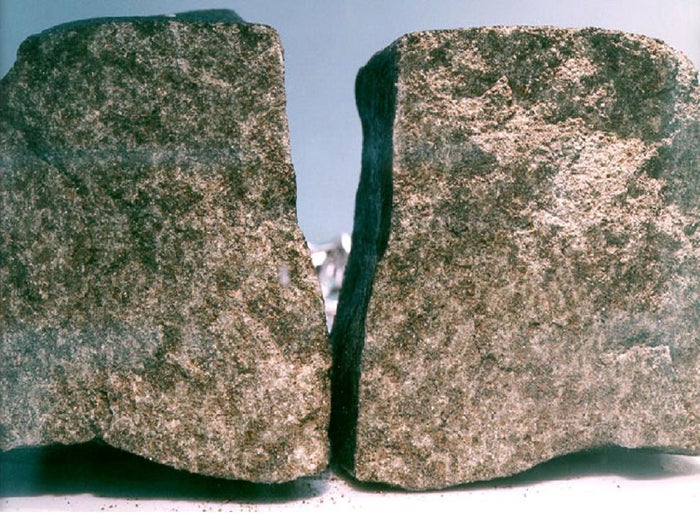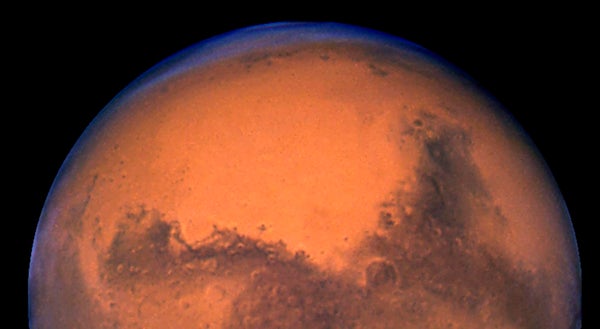This article was published in Scientific American’s former blog network and reflects the views of the author, not necessarily those of Scientific American
You can be forgiven for not necessarily associating the word "Mars" with the word "methane". After all, one of these is a 700,000,000,000,000,000,000 ton rocky planet circling our parent star. The other is a simple organic molecule that sometimes helps generate the hot water for your tea, or wafts across you when a cow belches in your face...if such things are part of your daily life.
But methane has become a critical and fascinating component in our attempts to understand the nature of Mars, and in the hunt for evidence of extinct or extant life beyond the Earth.
In simple terms; methane is a compound that can be intimately connected to life, via metabolism. Methane can be produced by methanogenic organisms living in low-oxygen environments (in particular certain species of archaea), but it's also a tasty, carbon-rich, food-stuff for methanotrophic life, and can be readily produced by geochemistry.
On supporting science journalism
If you're enjoying this article, consider supporting our award-winning journalism by subscribing. By purchasing a subscription you are helping to ensure the future of impactful stories about the discoveries and ideas shaping our world today.
Methane is also a compound that, in either Earth's oxygen-rich atmosphere, or the martian surface environment, tends to be transient. So if you find free methane wafting on the breeze, chances are there's an active source nearby - be it the microbes inside a cow, or an unseen cache of microbes underfoot, or something else.

Methane? Moi? (Credit: USDA)
For these reasons, planetary scientists, astronomers, and astrobiologists get very excited at claims of atmospheric methane on Mars. And there's been a significant recent history and debate over such claims - including the most recent evidence of a time-varying increase in methane concentration sensed by NASA's Curiosity rover.
Now a new study by Blamey et al. published in Nature Communications, adds another intriguing dimension to the question of martian methane, by looking at methane as a resource, rather than just biological effluvia.
By studying a number of known martian meteorite samples here on Earth, the researchers have measured a significant amount of methane apparently trapped within the rocky matrix of these objects. Since these meteorites consist of basic igneous material - formed from molten rock, or lava - one conclusion is that this methane was formed by non-biological processes, such as serpentization that produces hydrogen that later reacts to form methane. This deep sub-surface methane could be anaologous to what happens on Earth, and could provide an excellent energy source for any hungry martian microbes. Its existence therefore bolsters the idea that the martian environment could support life - now or in the past.
But how do we know that this methane is indeed indigenous to Mars?
The experiment involved the careful, machine-controlled, step-by-step crushing of small samples of meteorites, with any gaseous products passed into a mass spectrometer at each step. What came out of the crushing included methane, carbon-dioxide, hydrogen, nitrogen and traces of oxygen and argon. This mechanical extraction avoided any need to heat up the samples, which could have initiated new chemical reactions. The researchers also studied a range of meteorite samples - including non-martian ones - as well as a series of basalt 'blanks', or neutral control samples.

Part of the 'Nakhla' martian meteorite used in the study - it landed in 1911 in Egypt (Credit: NASA/JSC)
The upshot is that the majority of methane is unlikely to have come from the Earth, through diffusion after the meteorites had crashed to the ground. It is also unlikely to have originated after the rocks left Mars.
It's a tricky business though. Some of the meteorites show clear alteration due to sitting around in the wet terrestrial environment, but these samples also give up the least amount of any gases when crushed, so they certainly didn't gain a lot of gas, if any. Also, very different meteorites - carbonaceous chondrites that were never part of a planet - show far lower relative methane concentrations, again suggesting that the martian samples are indeed bearing methane from Mars's subsurface environment.
The debate is likely to continue, but these results seem to support the idea that somewhere on Mars, there have been, and perhaps still are, environments that are perfectly good for nuturing life as we know it.
